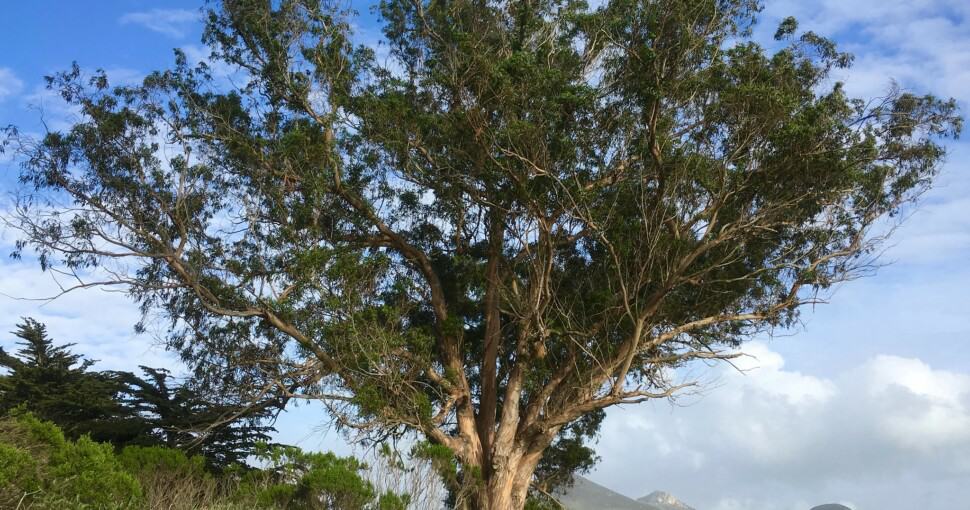Eucalyptus trees have a distinctive fragrance that is easily recognizable but can be tricky to identify visually. There are several visual characteristics that unite eucalyptus trees, though many other plant species have similar traits.
Contents
The Eucalyptus genus is indigenous to Australia. The genus is large and diverse, encompassing more than 700 tree species! Despite this variability, there are some common visual characteristics that most eucalyptus trees share.
Related: The 23 Biggest Trees in Australia
The mature eucalyptus leaves most of us are familiar with are generally glossy or waxy, with a silvery green color. Their leaves are petiolate and have a long, thin lanceolate shape. The margins of eucalyptus leaves are complete, with no serrations or indentations.
The bark of eucalyptus trees is also a telltale identification marker. Trees in this genus grow new bark annually. Eucalyptus shed the older, darker brown or gray bark, revealing the lighter-colored silvery-white fresh layer beneath (though a few species retain the old bark).
Eucalyptus trees produce distinctive flowers that look like fluffy balls. The flowers consist of a collection of stamens (giving the fluffed appearance) housed within a cap of fused sepals.
The color of these eucalyptus flowers ranges from yellow to red, pink, and white, depending on the species.
Related: Are Eucalyptus Leaves Poisonous?
Numerous other trees look like Eucalyptus species because they share these traits, including Australian blackwood, silver wattle, Sydney red gum, and red flowering gum.
1. Australian Blackwood (Acacia melanxylon)
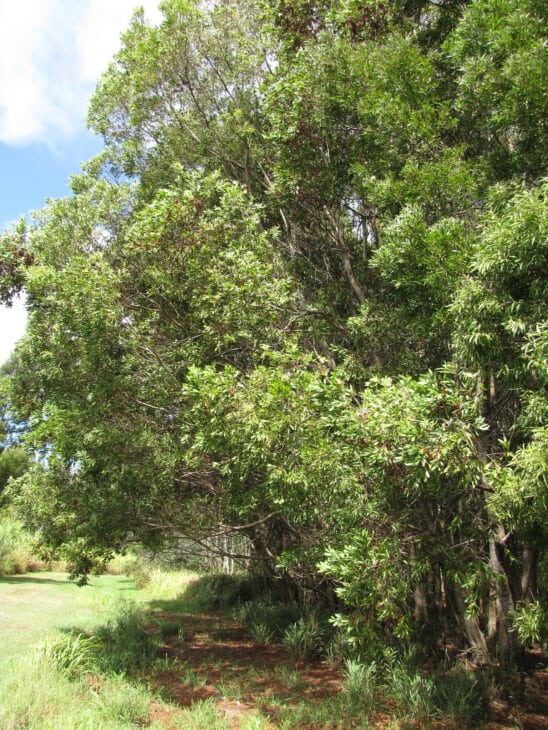
Australian blackwood has a similar appearance to eucalyptus trees. The foliage of this deciduous Australian native closely resembles that of species in the Eucalyptus genus, but it has phyllodes instead of ordinary leaves.
Phyllodes are extended petioles that are capable of photosynthesis and are common to the Acacia genus. The phyllodes of blackwood trees are lance-shaped with complete margins like eucalyptus leaves, and they share the same glossy, gray, or silver-green hue.
Australian blackwood’s peeling bark also makes the trees appear similar to a Eucalyptus species. Blackwood bark peels and has a scaly, fissured appearance. The bark flakes off the tree much like the tessellated bark of some eucalyptus trees.
There are some visual differences between blackwood and eucalyptus trees. Blackwood has brownish-black bark that is darker than most eucalyptus tree trunks. The flat, circular shape of Australian blackwood flowers is also markedly distinct from the round, fluffy eucalyptus blossoms.
2. Silver Wattle (Acacia retinodes)
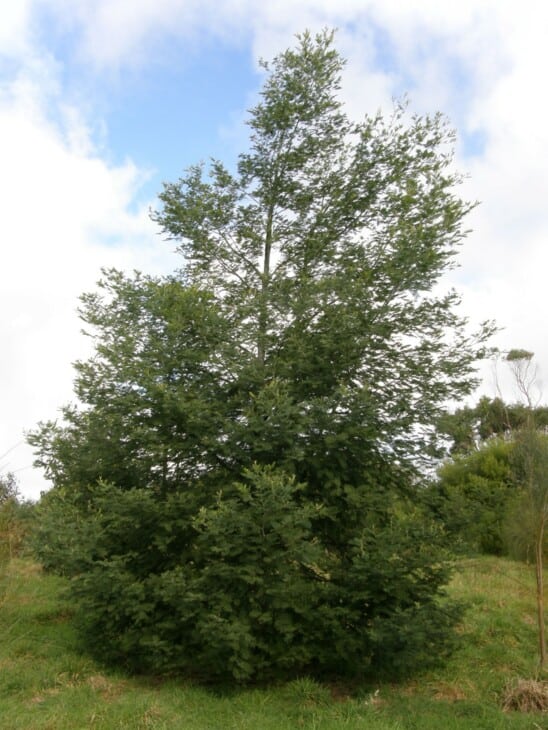
Silver Wattle is another Australian native that resembles eucalyptus trees. Similar to eucalyptus, mature silver wattle specimens have slightly oblong, lanceolate leaves with a glabrous (smooth, glossy) appearance. Silver wattle leaves also share a greyish-green color with eucalyptus.
The bark of A. retinodes also looks similar to that of species in the Eucalyptus genus. Silver wattle trees have dark brown bark that peels. The new bark underneath is silvery-gray bark, as with eucalyptus. Silver wattle trees produce round, fluffy yellow flowers (called racemes) resembling those of the eucalyptus.
Silver wattle is deciduous, so people might confuse them with eucalyptus during the summer growing season, but not in autumn and winter when A. retinodes drops its leaves. Another way to distinguish the trees is by comparing their height. Mature silver wattle trees are considerably shorter than full-grown eucalyptus.
3. Red Flowering Gum (Corymbia ficifolia)
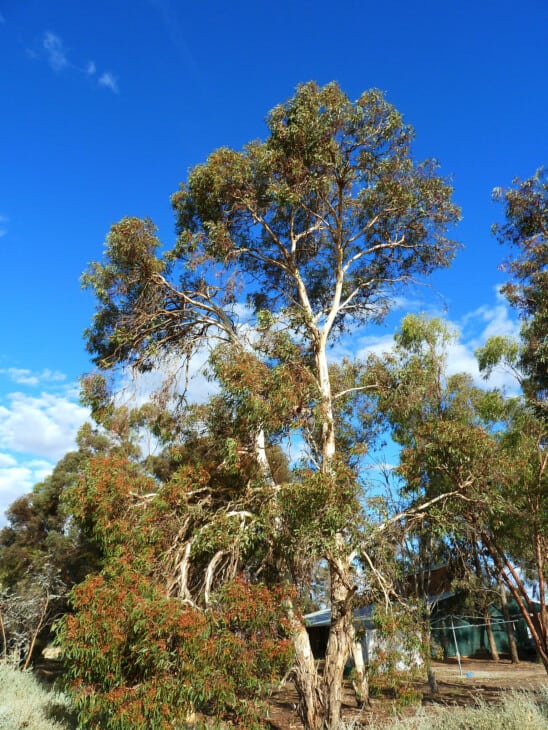
Red flowering gum is an evergreen tree species that looks like a eucalyptus. These trees look similar because the Corymbia and Eucalyptus genera are in the Eucalypteae tribe and are commonly called eucalypts.
Like Eucalyptus species, C. ficifolia has mature leaves with a lanceolate shape, though the leaf morphology is slightly rounder. The color of red flowering gum foliage is a glossy silvery-green, with a slightly paler shade on the underside of the leaves.
One might confuse red flowering gums and eucalyptus trees if one observes their trunks. Like Eucalyptus species, red flowering gums have light brown bark that peels off in lengthy, fibrous pieces.
The flowers of C. ficifolia and eucalyptus trees appear similar, but on closer inspection, one can notice some differences. Red flowering gums produce pinkish-red flowers that are more ball-like and less flattened than eucalyptus blossoms.
4. Large-Leaved Spotted Gum (Corymbia henryi)
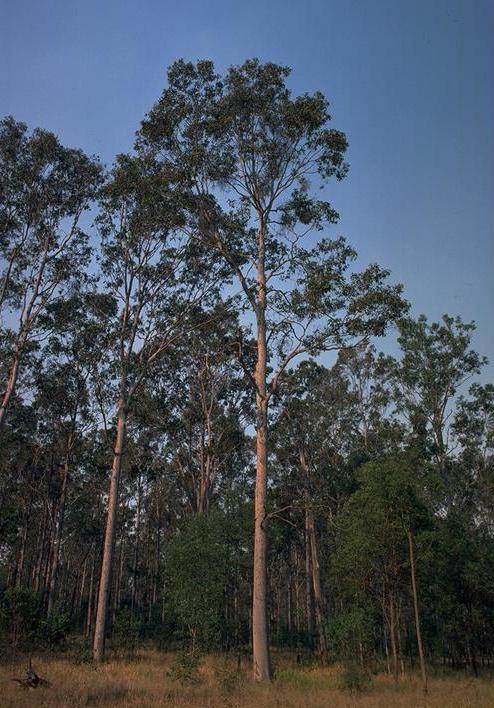
The large-leaved spotted gum is another Corymbia species one might mistake for eucalyptus. This species has shiny lanceolate leaves with smooth, non-serrated margins. The green color of the leaves is also similar to eucalyptus foliage.
Large-leaved spotted gums resemble many common Eucalyptus species due to the color of their bark. Like eucalyptus trees, C. henryi has smooth bark that is gray with orange and red undertones.
A primary difference between large-leaved spotted gums and eucalyptus trees is their floral structures. Unlike eucalyptus, large-leaved spotted gums produce pedicellate flowers, with buds on pedicels that attach to a single peduncle.
Another distinction is that C. henryi is deciduous, unlike the evergreen trees in the Eucalyptus genus. One can also tell C. henryi apart from eucalyptus trees by studying the texture of the bark. Large-leaved spotted gum bark is smooth with minimal or no peeling, in contrast to the heavily exfoliating bark of eucalyptus.
5. Sydney Red Gum (Angophora costata)
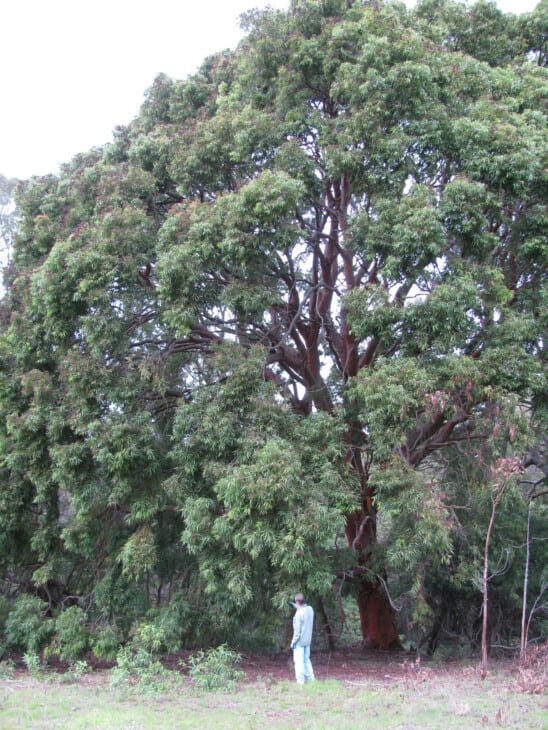
Sydney Red Gum has a clear and undeniable resemblance to eucalyptus trees because Angophora is the third type of eucalypt in the Eucalypteae tribe.
Sydney red gums are tall, evergreen trees with leaves that look very much like eucalyptus foliage. A. costata has glossy, gray-green leaves with a lance-like shape and complete margins. The leaves of Sydney red gums are also arranged in opposite pairs on the stem.
Distinguishing between the bark of Sydney red gum and eucalyptus trees is potentially challenging. The bark of Sydney red gums is brown with orange-pink undertones and peels off the trunk and branches in small pieces that look like scales.
The flowering structures on A. costata are reminiscent of eucalyptus flowers, but their cream-white colored oval blossoms have a peduncle-pedicel configuration that more accurately resembles that found on C. ficifolia.
6. Rough-Barked Apple (Angophora floribunda)
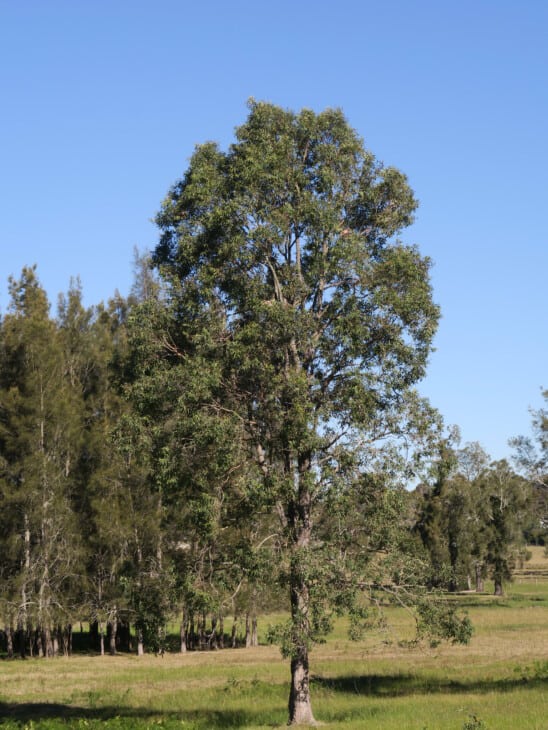
Rough-barked apple is a tree that convincingly impersonates Eucalyptus species. The leaves of A. floribunda have a grayish-green hue and lance-like shape typical of eucalyptus trees.
Like Eucalyptus species, rough-barked apple trees have fractured and uneven bark that peels off conspicuously. When the grayish-brown outer layers peel off, they reveal new bark with a beautiful light orange hue.
Rough-barked apple has creamy-white, fluffy, ball-shaped flowers that one can easily mistake for eucalyptus blossoms. If the trees are finished flowering, one can differentiate the urn-shaped fruit of A. floribunda from the smooth, round fruits of Eucalyptus species.
Another way to tell the difference between these trees is to observe them in winter. Rough-barked apple is deciduous, so it loses most or all of its leaves in winter, unlike the evergreen trees in the Eucalyptus genus.
7. Narrow-Leaved Apple (Angophora bakeri)
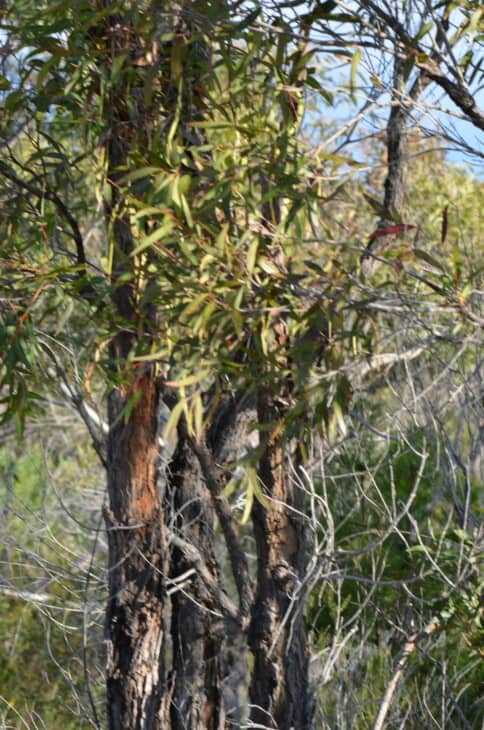
Narrow-leaved apple is a common species of Angophora with an uncanny resemblance to trees in the Eucalyptus genus. Like eucalyptus, A. bakeri has green lanceolate leaves with a glossy sheen.
Another visual similarity between narrow-leaved apple and eucalyptus trees is their bark. Like eucalyptus, narrow-leaved apple trees have bark that flakes off their trunks and branches. The older light grayish-brown bark contrasts with the darker colored orange-brown layers underneath.
Despite their similarities, it is possible to differentiate between these trees by comparing this particular feature. Narrow-leaved apple trees have rougher-looking bark with more pronounced fissures than eucalyptus trees, whose peeling trunks are noticeably smoother.
The flowers of narrow-leaved apple trees can be confused with the blossoms of eucalyptus when viewing them from far away. This species has cream or white fluff-ball blossoms that resemble eucalyptus flowers.
One can tell the trees apart by inspecting the structures of their flowers. Eucalyptus flowers consist of a dense arrangement of stamens, while A. bakeri has pedicellate flowers composed of three to seven buds on pedicels that branch off from a single peduncle.

